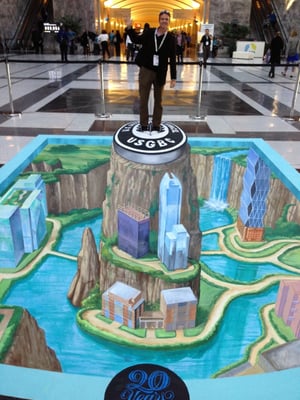Last week, Nina Szewczak, Chet Knaup and I visited this year’s Greenbuild conference in the beautifully-gray city of Philadelphia. It’s always great to see such a large crowd of building professionals - 10,000 or so – and feel the enthusiasm and optimism about improving our built environment. We split up and covered a lot of ground, and I think we all learned a lot during our time there.
For myself, I took away these things. 
1) Philadelphia has a lot of bars.
2) I am just as good at not seeing Bon Jovi in my forties as I was in my twenties.
3) If you get a man hungry enough, he’ll eat a sausage sandwich off the dirty floor of a sports arena.
And there were other, less profound things to be discovered.
1) LEED Version 4 has finally launched, although there will be nearly two more years in which a project may be registered in Version 3. Version 4 has been delayed, maligned, and feared, mostly because it has revamped credits related to materials and resources and requires much more information related to their production and life cycle impact. It also tightens up on the energy points by requiring proposed buildings to improve upon ASHRAE 90.1-2010. This version of the energy efficiency standard is significantly more stringent than 2007’s which served as the baseline for LEED V3.
For our part, I’d like to see our company embrace the new system rather than hide behind Version 3. It’s coming either way, and within a few months we’ll need to meet ASHRAE 90.1-2010 as it will be required for all or most federal jobs. There have been over 100 pilot projects for V4, and I’m convinced certification is achievable. The USGBC has been clear from the beginning that they will be continuing to raise the bar on the LEED system.
2) LEED Dynamic is a brand new system that provides real-time performance rating for an existing building. I’m still learning about this, but the idea is pretty cool since the plaque itself is a type of dashboard that shows how the building is working in a variety of categories. The system promises to be more about actual performance than prescriptive requirements and it might end up being a replacement to the Building Operations and Maintenance rating system which the USGBC acknowledges gets relatively little interest even for buildings that have achieved LEED for New Construction.
3) The Architecture 2030 Palette was released during a really good talk by Ed Mazria in which he displayed the positive progress made in energy and greenhouse gas reductions during the past decade since Architecture 2030 was created. (The Architecture 2030 organization started the 2030 Challenge which is an initiative to have all new buildings reach Net Zero fossil-fuel energy by the year 2030. We have signed on to this challenge.) The 2030 Palette is an interactive website that provides general guidance on strategies and measures that can be used in net-zero design. The site provides basic rules of thumb for each strategy together with many other learning resources.
4) UL Environmental’s LEED Toolkit was rolled out at the beginning of the conference. As stated above, there’s a lot of uncertainty and concern over the material and resources credits in the new V4 system. These credits require Environmental Product Declarations (EPDs) on building materials, but such information is not yet widely available.
Most of us know UL as a large testing laboratory that provides certifications on the safety and compliance of equipment, particularly related to electrical and fire safety. UL Environmental provides certification for EPDs ensuring that the documents include the necessary information to demonstrate the environmental impact of a product over its life cycle.


